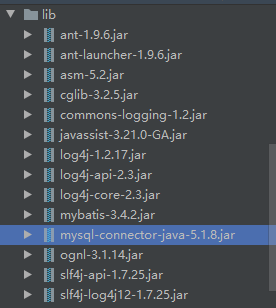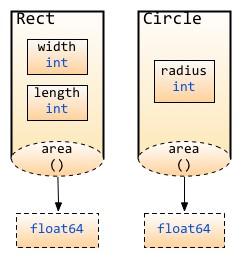目录
一、概述
(一)项目准备工作
(二)项目结构描述
(三)具体作用概述
二、举例
(一)步骤
(二)实例
一、概述
(一)项目准备工作
0、思路:(个人理解,有可能有误因为是自学的。)
第一、mybatis是操作数据库,或者是跟持久层打交道的(我对着二个的理解就是实体类跟数据库的关系操作),需要配置一个mybatis的信息(1。需要配置数据库信息,如:mysql的登录密码账户等。2.sql语句的位置。),,因此创建了一个mybatis-config.xml文件。
第二、根据不同的实体类,创建不同的mapper.xml文件。这个文件里面是增删改查的sql语句。
第三、测试类里面可以通过(命名空间+id)来访问mapper.xm里面具体的sql语句。并交给sqlsession执行。
第四、测试类里面获取了mybatis-config.xml的核心配置,mapper位置,通过InputStream、SqlSessionFactory、SqlSession来构建成一个整体。直接传入参数,SqlSession执行mapper.xml里面的语句。
1、下载MyBatis。目标地址:https://github.com/mybatis/mybatis-3/releases?after=mybatis-3.4.4 (需要lib里面的所有JAR包、mybatis-3.4.2.jar(或者是其他的版本号))
2、数据库驱动jar包。如:mysql-connector-java-5.1.8.jar
(我的网盘链接:链接:https://pan.baidu.com/s/1ELGxGTauH40AUjgORvcrOQ
提取码:75oo
复制这段内容后打开百度网盘手机App,操作更方便哦)
(二)项目结构描述

(三)具体作用概述
1、log4j.properties主要是日志信息,效果如下:能把需要的日志信息打印在控制台上。(我是这么理解的)

2、mybatis-config.xml 这个配置文件主要作用:1、配置MyBatis的相关信息。2、数据库的连接属性(配置数据库如:Mysql,Oracle)。3、指定相关的mapper.xml文件的位置。
3、CustomerMapper.xml 这个配置文件主要作用是:1、写Sql语句。进行增删改查。
4、Customer 是一个实体类。
5、MybatisTest 是一个测试类。
二、举例
(一)步骤
1、导入相关jar包。
2、编写所有需要的配置文件。
3、创建实体类。
4、创建测试类。
(二)实例
1、导入相关jar包。
见项目准备,自行下载。(还有一个可以自行导入的JNUIT4。是一个单元测试的。通过工具可以直接导入。)

2、编写所有需要的配置文件。
(1)log4j.properties
# Global logging configuration
log4j.rootLogger=ERROR, stdout
# MyBatis logging configuration...
log4j.logger.com.stx=TRACE
# Console output...
log4j.appender.stdout=org.apache.log4j.ConsoleAppender
log4j.appender.stdout.layout=org.apache.log4j.PatternLayout
log4j.appender.stdout.layout.ConversionPattern=%5p [%t] - %m%n
#这个日志文件的主要目的是为了在:控制台输出Sql语句。作用是:输出日志信息。这段代码在mybatis的操作手册里面可以查到。(2)mybatis-config.xml
<?xml version="1.0" encoding="UTF-8" ?>
<!DOCTYPE configuration PUBLIC "-//mybatis.org//DTD Config 3.0//EN"
"http://mybatis.org/dtd/mybatis-3-config.dtd">
<configuration>
<!-- 1.配置环境,默认的环境id为mysql-->
<environments default="mysql">
<!-- 1.2.配置id为mysql的数据库环境-->
<environment id="mysql">
<!-- 使用JDBC的事务管理器。-->
<transactionManager type="JDBC"></transactionManager>
<!-- 数据库连接池-->
<dataSource type="POOLED">
<property name="driver" value="com.mysql.jdbc.Driver"/>
<property name="url" value="jdbc:mysql://localhost:3306/mybatis"/>
<property name="username" value="root"/>
<property name="password" value="123456"/>
</dataSource>
</environment>
</environments>
<!-- 2.配置Mapper的位置。-->
<mappers>
<mapper resource="com/stx/mapper/CustomerMapper.xml"></mapper>
</mappers>
</configuration>(3)CustomerMapper.xml
<?xml version="1.0" encoding="utf-8" ?>
<!DOCTYPE mapper PUBLIC "-//mybatis.org//DTD Mapper 3.0//EN"
"http://mybatis.org/dtd/mybatis-3-mapper.dtd">
<!--!DOCTYPE mapper PUBLIC "-//mybatis.org//DTD Mapper 3.0//EN"
"http://mybatis.org/dtd/mybatis-3-mapper.dtd"
1、这一段是MyBatis的约束配置。
-->
<!--2、以下是映射信息-->
<!--
mapper是配置文件的根元素。
namespace 为这个<mapper>指定唯一命名空间。通常设置为:包名+sql映射文件。这个实在JAVA类里面的访问名称。通过这个名称来找到这个mapper的。
<select> 是mapper的子元素,用于执行查询操作。
id 属性是唯一标识,
parameterType 指定传入参数的类型。
resultType 指定返回结果类型。
#{} 表示一个占位符。相当于?,而#{id}表示该占位符待接收参数的名称为id。
-->
<mapper namespace="com.stx.mapper.CustomerMapper">
<select id="findCustomerById" parameterType="Integer" resultType="com.stx.po.Customer">
select * from t_customer where id=#{id}
</select>
<!-- ************************************************************** -->
<!-- ${}:用来表示拼接SQL的字符串,即不加解释的原样输出。${value}表示要拼接的是简单类型参数。这样无法防止SQL注入。
防止措施:使用MySQL中的concat()函数进行字符串拼接。
-->
<!-- <select id="findCustomerByName" parameterType="String" resultType="com.stx.po.Customer">-->
<!-- select * from t_customer where username like '%${value}'-->
<!-- </select>-->
<select id="findCustomerByName" parameterType="String" resultType="com.stx.po.Customer">
select * from t_customer where username like concat('%',#{value},'%')
</select>
<insert id="addCustomer" parameterType="com.stx.po.Customer">
insert into t_customer(username,jobs,phone)
values(#{username},#{jobs},#{phone})
</insert>
<select id="findAllCustomer" parameterType="String" resultType="com.stx.po.Customer">
select * from t_customer
</select>
<update id="updateCustomer" parameterType="com.stx.po.Customer">
update t_customer set username=#{username},jobs=#{jobs},phone=#{phone}
where id=#{id}
</update>
<delete id="deleteCustomer" parameterType="Integer">
delete from t_customer where id=#{id}
</delete>
</mapper>3、创建实体类。Customer
package com.stx.po;
public class Customer {
private Integer id;//主键
private String username;//客户名称
private String jobs;//职业
private String phone;//电话
public Integer getId() {
return id;
}
public void setId(Integer id) {
this.id = id;
}
public String getUsername() {
return username;
}
public void setUsername(String username) {
this.username = username;
}
public String getJobs() {
return jobs;
}
public void setJobs(String jobs) {
this.jobs = jobs;
}
public String getPhone() {
return phone;
}
public void setPhone(String phone) {
this.phone = phone;
}
@Override
public String toString() {
return "Customer{" +
"id=" + id +
", username='" + username + '\'' +
", jobs='" + jobs + '\'' +
", phone='" + phone + '\'' +
'}';
}
}
4、创建测试类。MybatisTest
package com.stx.test;
import com.stx.po.Customer;
import org.apache.ibatis.io.Resources;
import org.apache.ibatis.session.SqlSession;
import org.apache.ibatis.session.SqlSessionFactory;
import org.apache.ibatis.session.SqlSessionFactoryBuilder;
import org.junit.Test;
import java.io.InputStream;
import java.util.List;
//入门测试程序
public class MybatisTest {
@Test
public void findCustomerByIdTest() throws Exception{
// 1、读取配置文件,这个文件是MyBatis的核心配置文件。
String resource = "mybatis-config.xml";
InputStream inputStream =
Resources.getResourceAsStream(resource);
// 2、根据配置文件构建SqlSessionFactory
SqlSessionFactory sqlSessionFactory =
new SqlSessionFactoryBuilder().build(inputStream);
// 3.通过SqlSessionFactory创建SqlSession
SqlSession sqlSession = sqlSessionFactory.openSession();
// 4.SqlSession执行映射文件中定义的sql,并返回映射结果。
Customer customer = sqlSession.selectOne("com.stx.mapper.CustomerMapper.findCustomerById",1);
// 打印输出结果。
System.out.println(customer.toString());
// 关闭SqlSession
sqlSession.close();
}
@Test
public void findCustomerByNameTest() throws Exception{
String resource ="mybatis-config.xml";
// 把配置文件作为输入流输入进去。
InputStream inputStream = Resources.getResourceAsStream(resource);
// 根据配置文件构建sqlSessionFactory
SqlSessionFactory sqlSessionFactory = new SqlSessionFactoryBuilder().build(inputStream);
// 通过sqlSessionFactory创建sqlSession
SqlSession sqlSession = sqlSessionFactory.openSession();
List<Customer> customers = sqlSession.selectList("com.stx.mapper.CustomerMapper.findCustomerByName","j");
for (Customer customer:customers){
System.out.println(customer);
}
sqlSession.close();
}
@Test
public void addCustomerTest() throws Exception{
// 1、读取配置文件
String resource = "mybatis-config.xml";
// 2、根据配置文件构建SqlSessionFactory
InputStream inputStream = Resources.getResourceAsStream(resource);
// 3、通过SqlSessionFactory创建SqlSession
SqlSessionFactory sqlSessionFactory = new SqlSessionFactoryBuilder().build(inputStream);
SqlSession sqlSession = sqlSessionFactory.openSession();
// 4.SqlSession执行添加操作
// 4.1、创建Customer对象,并向对象中添加数据
Customer customer = new Customer();
customer.setUsername("Rose");
customer.setJobs("Student");
customer.setPhone("13996593272");
// 4.2、执行SqlSession的插入方法,返回的是sql语句的影响行数。
int rows = sqlSession.insert("com.stx.mapper.CustomerMapper.addCustomer",customer);
// 4.3、通过返回结果判断插入操作是否执行成功。
if (rows>0){
System.out.println("您成功插入了"+rows+"条数据!");
}else {
System.out.println("执行插入操作失败了!!");
}
// 4.4、提交事务。
sqlSession.commit();
// 5、关闭SqlSession
sqlSession.close();
}
@Test
public void findAllCustomerTest() throws Exception{
String resource = "mybatis-config.xml";
InputStream inputStream = Resources.getResourceAsStream(resource);
SqlSessionFactory sqlSessionFactory = new SqlSessionFactoryBuilder().build(inputStream);
SqlSession sqlSession = sqlSessionFactory.openSession();
List<Customer> customers =sqlSession.selectList("com.stx.mapper.CustomerMapper.findAllCustomer");
for (Customer customer:customers){
System.out.println(customer);
}
sqlSession.close();
}
@Test
public void updateCustomerTest()throws Exception{
String resource = "mybatis-config.xml";
InputStream inputStream = Resources.getResourceAsStream(resource);
SqlSessionFactory sqlSessionFactory = new SqlSessionFactoryBuilder().build(inputStream);
SqlSession sqlSession = sqlSessionFactory.openSession();
Customer customer = new Customer();
customer.setId(4);
customer.setUsername("Rose");
customer.setJobs("Programmer");
customer.setPhone("13131111111");
int rows=sqlSession.update("com.stx.mapper.CustomerMapper.updateCustomer",customer);
if (rows>0){
System.out.println("您成功修改了"+rows+"条数据!");
}else {
System.out.println("执行修改操作失败了!!!");
}
sqlSession.commit();
sqlSession.close();
}
@Test
public void deleteCustomerTest() throws Exception{
// 1、把配置文件赋值。
// 2、把配置文件加载成为字符字节流。读取配置文件
String resource = "mybatis-config.xml";
InputStream inputStream = Resources.getResourceAsStream(resource);
// 2、根据配置文件构建SqlSessionFactory
SqlSessionFactory sqlSessionFactory = new SqlSessionFactoryBuilder().build(inputStream);
// 3、通过SqlSessionFactory创建SqlSession
SqlSession sqlSession = sqlSessionFactory.openSession();
// 4、SqlSession执行删除操作。
// 4.1 SqlSession执行删除方法,返回的是SQL语句影响的行数
int rows = sqlSession.delete("com.stx.mapper.CustomerMapper.deleteCustomer",4);
// 4.2 通过返回结果判断是否删除成功。
if (rows>0){
System.out.println("成功删除了"+rows+"条数据!");
}else {
System.out.println("执行删除操作失败!!!");
}
// 提交事务
sqlSession.commit();
// 关闭sqlSession
sqlSession.close();
}
}





